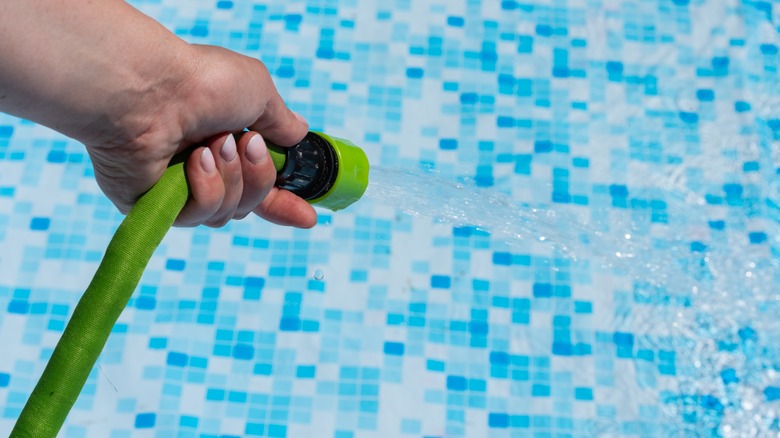Is Your Pool Leaking Water? This Clever Bucket Hack Will Let You Know For Sure
Deciding whether or not to install a pool in your backyard comes down to a few key factors. There's choosing the right pool design, of course, but you'll also need to think about budget and maintenance. A well-maintained in-ground pool can last decades, but you'll need to keep a close eye on pH levels, always fill your pool with just the right amount of water, and pay attention to any possible issues. Leaks are one of the biggest problems that can occur, and spotting one early can prevent permanent damage to the pool itself, as well as to the surrounding area. On average, swimming pools lose about ¼ of an inch of water each day (more in particularly hot months) due to evaporation, high winds, and splashing. A solar cover can easily decrease evaporation. However, if you suspect a leak, you'll need to call in professional help ASAP. In order to confirm you actually have a leak, there's a simple test you can do yourself, which only requires a 5-gallon bucket and some tape.
At the same time, look out for other telltale signs, including suddenly soggy grass, standing water around the pool, cracks in the lining or tiles, and algae growth. A pool with a leak will also require more chemicals to keep its pH balanced. It may also lead to a higher than normal water bill. If you've spotted any of these issues, it's definitely time for the bucket test.
How to carry out a pool bucket test
In order to rule out evaporation and confirm a leak, you'll need to fill your 5-gallon bucket with pool water (go up until 1 inch from the top) and place it on one of the top two steps in your pool so it's partially submerged and the water level in the bucket is even with the water level in the pool. Turn off your pump and autofill device (if you have one) and use two pieces of tape to mark the water level inside and outside the bucket. Make sure the water level in your pool is what it would be under normal circumstances, then let the bucket sit for exactly 24 hours. If it rains at any point, you'll need to restart the test.
When you analyze the water levels the following day, whatever decrease you see inside the bucket will have been caused solely by evaporation. If the water level in the pool dropped by more, a leak is likely the culprit. At that point, you can carry out secondary testing to pinpoint the cause of the issue. Fill up the pool to mid-skimmer, mark the water level, and turn the pump back on (while leaving autofill off). If, after 24 hours, the level is lower, you may have a plumbing issue. Next, repeat the same test, but with the pump off. If the water drops by the same amount as the previous day, the leak isn't in the plumbing, but rather in the shell of the pool. Either way, you'll want to fix it as quickly as possible to prevent further damage.
